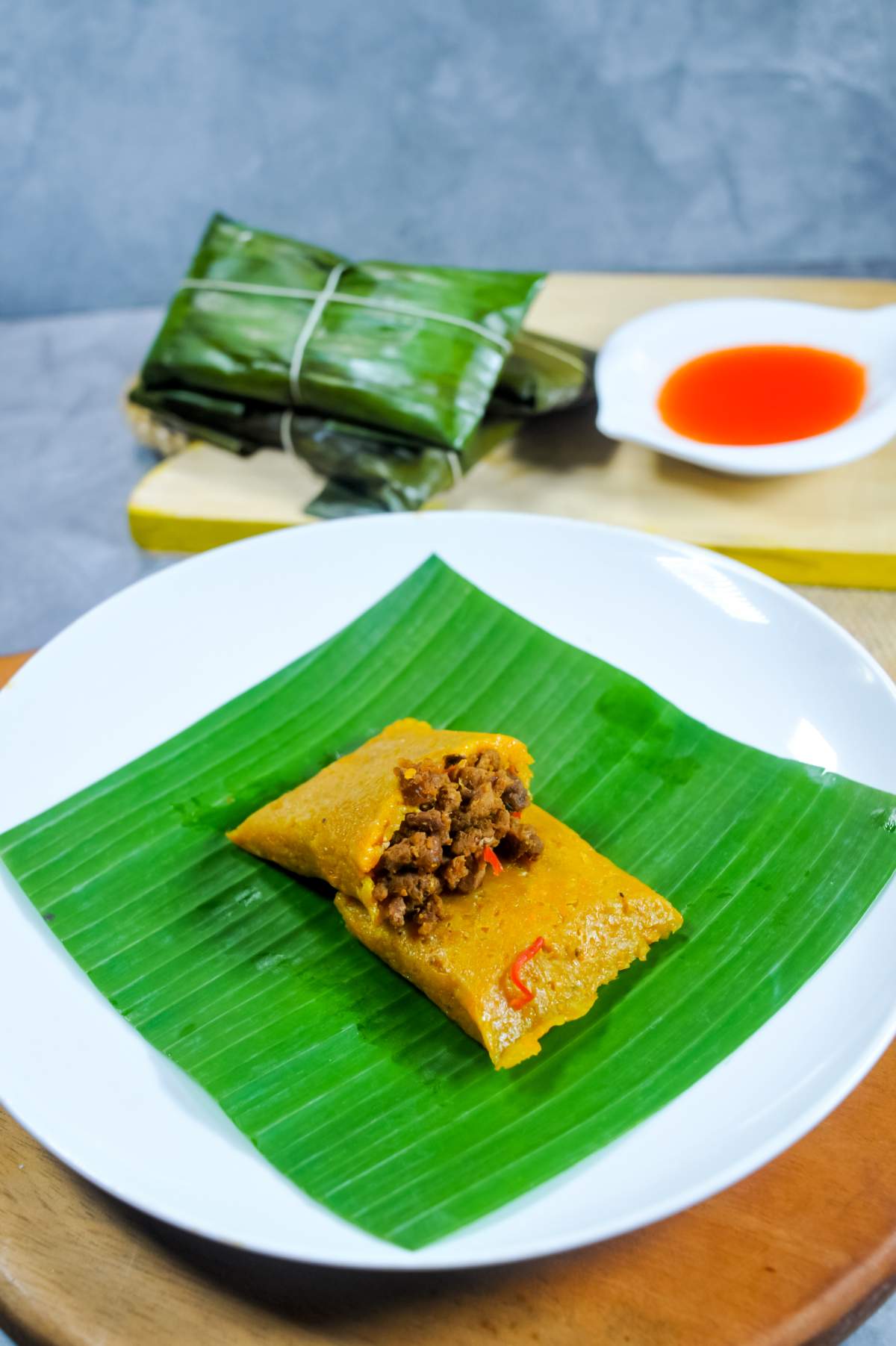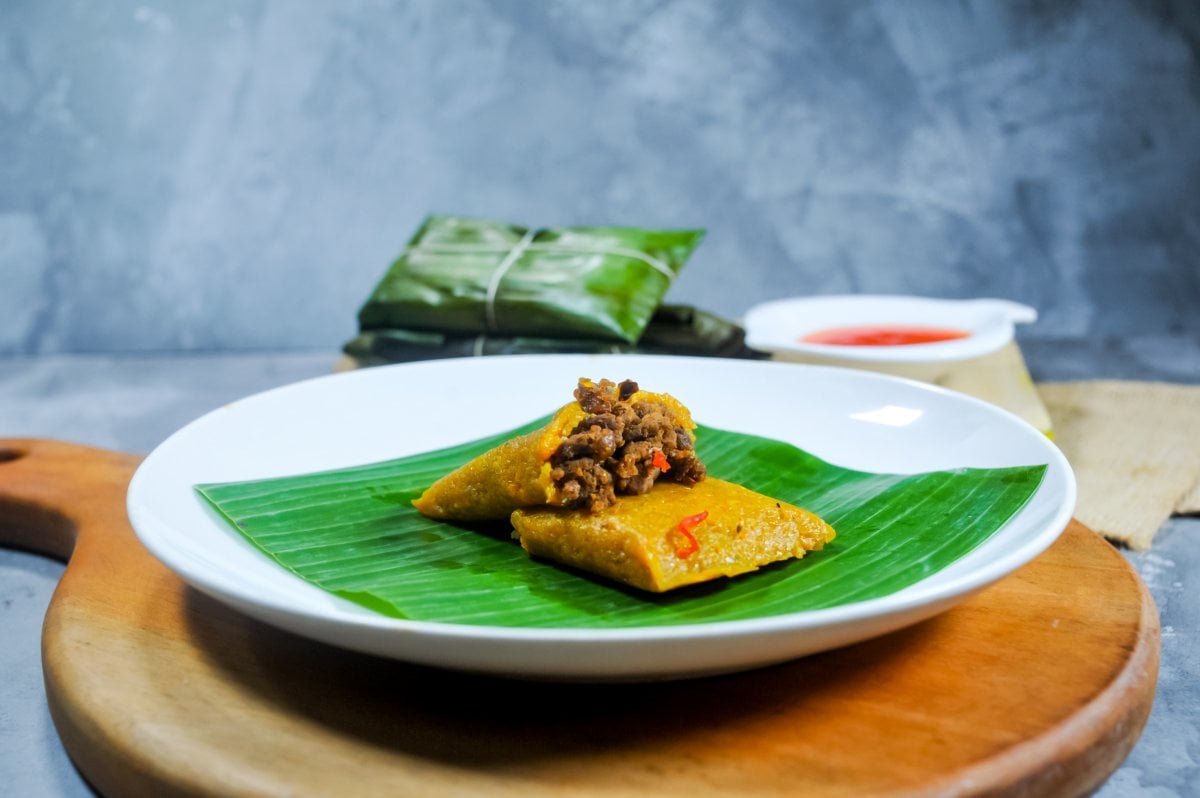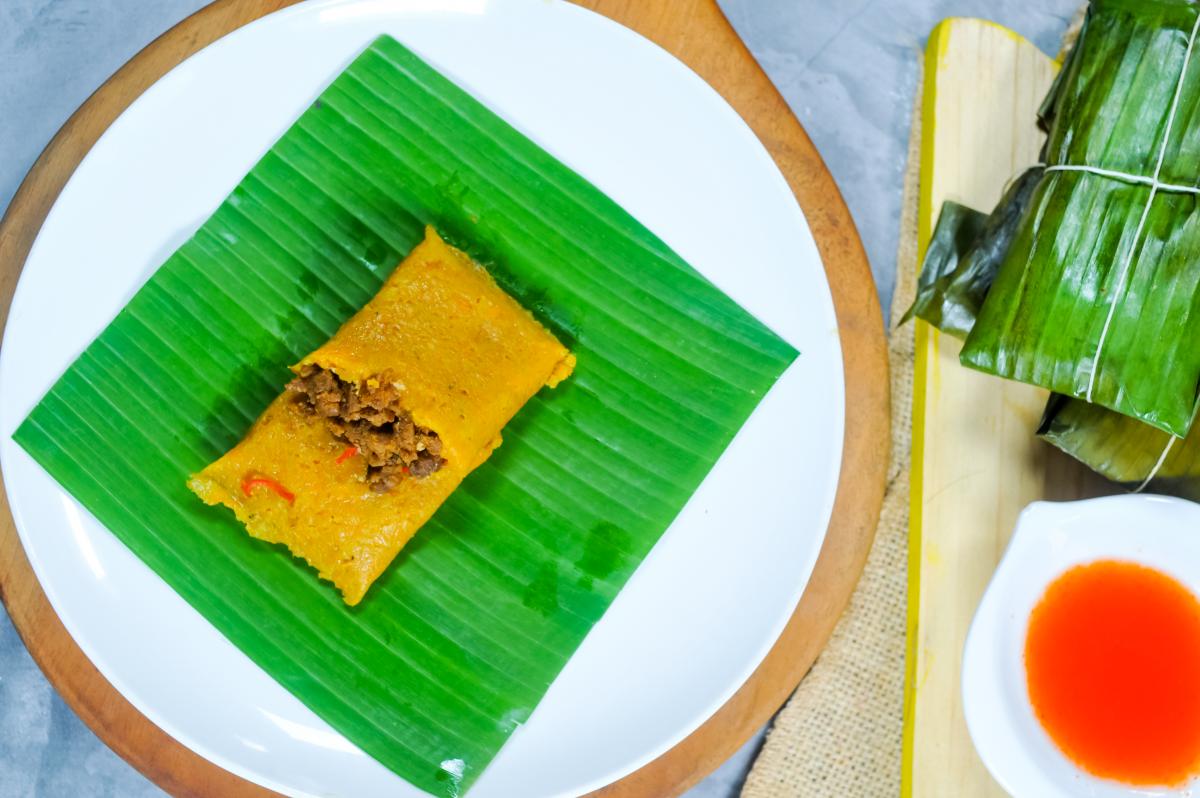Pasteles En Hoja (Dominican Plantain And Beef Pockets)
Today I will show you how to make authentic Dominican Pasteles en Hoja. These beef and vegetable masa pockets are quite easy to make and don’t take too long.
They are packed with loads of savory rich flavors, and they are relatively nutritious. And the best part is that you can make a bunch and freeze them for later use!

What Are Pasteles En Hoja?
Pasteles en Hoja are popular Dominican and Puerto Rican Christmas snacks. They are very similar to Mexican Tamales but made from different ingredients. Tamales are also steamed whereas pasteles are traditionally boiled.
First, we have vegetable masa dough. It is made from a combination of plantains, white cocoyam, and pumpkin. These vegetables are finely grated to create a thick dough-like mixture. Some traditional Dominican seasoning ingredients are added to give it a delicious complex savory flavor.
Then, you have the filling. Now traditionally the filling that is used is beef-based. However, many recipes also use ground chicken or pork instead.
Today we will make a beef picadillo recipe from scratch. It is one of the most popular fillings used for Dominican Pasteles en Hoja.
Once the veggie masa and beef filling have been made, you can assemble the pasteles. As I’ve mentioned, the process is similar to folding tamales.
If you aren’t sure how to wrap tamales in plantain leaves, have a look at this tutorial.
Once the Dominican plantain leaf pockets have been wrapped, you can boil them for 30-40 minutes or until they are done.
It’s as easy as that! So, let’s take a look at some substitutes for hard-to-find ingredients and how to make Pasteles en Hoja.

How to make Pasteles En Hoja
Making Pasteles En Hoja is a bit time-consuming but not difficult. The most challenging part is wrapping the masa in the plantain leaves. But, once you get the hang of it, it gets easier with each one.
The first thing you will need to do is make the beef picadillo filling. I like to do this first so that it has time to cool while I work on the dough.
To make the beef picadillo, start by heating some olive oil, add the chopped onion, and sauté until it is translucent.
Next, add the ground beef, seasoning and herbs, and cook until it is browned. Drain any excess fat and remove it from the heat. Let it cool completely before using.
While the beef filling is cooling, you can make the plantain masa. Start by peeling and grating the plantains and cocoyam.
Then, add the kabocha squash (or pumpkin), grated onion, garlic, and cilantro. Mix everything together until it is well combined, then add the seasonings and mix everything together.

Now that the masa is done, it is time to assemble the Pasteles En Hoja. You will need to have your plantain leaves and beef filling ready to go.
To start, take a plantain leaf and cut out the stem. You will want to use leaves that are pliable but not too fragile.
Next, take a scoop of masa and place it in the center of the leaf. Spread it out into a rectangle, then add a spoonful of beef filling down the center.
Fold up the bottom of the leaf, then bring up the sides and tie with string or plantain leaf strips.
Repeat this process until you have used up all of the masa or leaves.
Now, you can boil the Pasteles En Hoja for 30-40 minutes or until they are cooked through.
About The Ingredients And Substitutes You Can Use
The ingredients in the beef filling that may be challenging to find are the adobo and sazon culantro.
Here is a list of adobo substitutes if you cannot find any at your local Latin American grocer.
You can find Sazon culantro on Amazon and even at Walmart. You shouldn’t have any issues locating some.
Moving on to the vegetable filling for this Pasteles En Hoja recipe, there are definitely more uncommon ingredients. Most of them you will be able to find at a Latin American or African grocer.
If you cannot find cocoyam, many people recommend using oats instead. I would also just recommend using cassava root or even sweet potato. Any root that isn’t too high in moisture.
Kabocha squash is the best type of pumpkin to use. But, it isn’t available worldwide. So, use whichever you can find.

Tips And Tricks
- When you grate the vegetables, use the finest side on your grater.
- You can also make the vegetable filling in a blender or food processor. It will create a much finer-textured mixture.
- When rolling your Pasteles, make sure to roll them tightly. This way the filling will be well contained and each pocked stuffed with filling.
FAQs
Are Pasteles En Hoja healthy?
These are relatively healthy pockets. Each of them contains about 300 calories. Now, this may seem like a ton. But remember that you won’t be able to eat as much as you think.
And there are ways you can reduce this number. For example, use extra lean ground beef and reduce the number of oily ingredients you use.
What can you serve with these plantain and beef pasteles?
Serving these pasteles with rice is a great way to elevate the flavors of the pockets without overwhelming them. This Jamaican Rice and Peas or any Caribbean rice recipe is my go-to option.
You can also serve them with any sauce. My family and friends love a hot sauce or ketchup accompaniment with these pasteles.
Can you freeze Pasteles en Hoja?
Once you have shaped and assembled the beef pockets, you can easily freeze them for up to a month! Stack the pockets inside an airtight container and place them in your freezer. To cook, you don’t need to thaw them first. Simply boil them from frozen for at least 1 hour.
More Dominican Recipes
• Ensalada Rusa
• Mangú From Scratch
• Asopao de Camarones

Pasteles En Hoja (Dominican Plantain And Beef Pockets)
Ingredients
For the beef picadillo filling
- 1 tbsp vegetable oil
- 1 small green bell pepper, chopped
- 1 small red onion, chopped
- 4 garlic cloves, minced
- 1 pound lean ground beef
- 1 tsp adobo
- 1/2 tsp freshly ground black pepper
- 1 tsp dried oregano
- 1 pack sazon culantro
- 1/4 cup tomato sauce
- 1 cup vegetable or beef stock
- 1 tsp lime juice
- 1 tbsp fresh cilantro, chopped
For the Pasteles en Hoja
- 2 large green plantains, peeled, finely grated
- 1 pound white cocoyam (malanga or yautia root), peeled, finely grated
- 1 pound pumpkin (preferably kabocha squash), peeled, finely grated
- 1 tsp adobo seasoning
- 2 tbsp sofrito mix
- 1 tbsp annatto/achiote powder
- Plantain or banana leaves
Instructions
Make the beef picadillo filling
- Add the oil to a large skillet over medium-high heat. Add the onion and leave it to sweat for about 5 minutes.
- Next, add the bell pepper and allow it to cook for a minute or two.
- Finally, add the minced garlic and fry it for a minute.
- Once the garlic has been fried, break up the beef mince and add it to the pan. Allow it to become brown for a couple of minutes.
- Add the adobo, black pepper, pregano, and sazon. Mix the ingredients well so that the flavors are distributed well. Allow the flavors to cook for a minute or two.
- Next, add the tomato sauce and stock. Bring the mixture to a boil. Then, reduce the heat and allow it to simmer for about 15 minutes. Most of the liquid should evaporate.
- Once your beef picadillo is ready, stir in lime juice and the freshly chopped cilantro.
- Allow the beef filling to cool completely before using it in your Pasteles en Hoja recipe.
Prepare the plantain leaves
- Cut parchment paper into 10-inch squares. Set them aside.
- Wash your plantain leaves well and rinse off any debris.
- Then, blanch them in boiling water for about 30-60 seconds. This will help make them more pliable and easier to work with.
- Once they have softened, plunge them into ice-filled water to stop the cooking. Allow them to cool completely.
- Then, cut the plantain leaves into 6-inch squares. Set them aside.
Make the Pasteles en Hoja
- Combine the finely grated vegetables (plantains, cocoyam, and pumpkin) in a large mixing bowl.
- Add the adobo, sofrito, and annato powder. Mix these ingredients together well. Set them aside.
- Move to a big workspace. Stack the plantain squares on top of the parchment paper squares.
- Add 2 tablespoons of the masa mixture (grated seasoned vegetables) into the center of the plantain leaf square. Spread it into a square, leaving a 1/2-1 inch border.
- Then add about 2 tablespoons of your cooled beef picadillo filling.
- Cover the beef with 2 more tablespoons of the vegetable filling.
- Fold the leaf over to make an enclosed envelope. Then, wrap the parchment paper around it and secure it with some twine.
Cook the Pasteles en Hoja
- Bring a large pot of water to a rolling boil. Once boiling, leave the pockets to cook for about 30-40 minutes.
- For frozen pockets, you should boil them for at least an extra 15-20 minutes.
- Once cooked, unwrap them and serve them with your favorite sauce or accompaniment.



